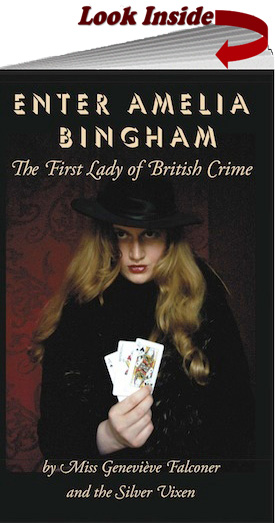
 by Geneviève Falconer and the Silver Vixen
by Geneviève Falconer and the Silver Vixen
This book revolves around the exploits of the eponymous Amelia Bingham, an elegant confidence trickster who confines her craft to people she deems deserving of being fleeced for their contribution to the general ugliness and coarseness of contemporary society.
The most famous crime-fighting duo of all time was that of Sherlock Holmes and Dr. Watson. Even as Sir Arthur Conan Doyle was still writing the Sherlock Holmes stories, his brother-in-law E. W. Hornung wrote about an inverse duo – A.J. Raffles and Bunny Manders – the gentleman thief and his partner in crime.
A hundred years later – in the 1980s – Amelia Bingham and the hon. Hypatia (“Pash”) Chevender were conceived as a kind of feminine Raffles and Bunny.
As with Watson and Bunny, the charming but naive Pash is the narrator of the tales, many of which first appeared in the magazine Artemis. They were later collected into a book with substantial additional material which essentially forges the original short stories into a novel of the adventures of one of the most remarkable characters to grace the world of feminine crime – Amelia Bingham.
Just as Raffles moved in a world of London gentlemen’s clubs and aristocratic country houses, Amelia moves in the world of her London residential ladies’ club and some highly exclusive feminine country houses. As the stories unfold we soon learn that Amelia is by no means alone in her style and attitudes and that many of her circle make their livings in ways as unusual as her own.
Later we are introduced to a remote Scottish mansion which is home to a feminine household where all-girl balls and crinoline parties form the centerpiece of an elegant style of life that is supported by a well-organized smuggling operation. At no point does Miss Bingham give her attention to smuggling itself, but when the household is threatened by an ill-intentioned outsider, she does turn her hand to a little detective work before ending her time in Scotland with a highly lucrative coup against a government department.
While the novel is set in the 1980s, the feminine society it depicts is as staunchly traditional as the world of Sherlock Holmes, but in a thoroughly girl-oriented redaction. Behind the wit and gaiety and even the apparent amorality, lay in each member of the sisterhood a resolution to create an oasis of truth and beauty in a corrupt world, and of true, strong and elegant femininity in a world ever more submerged in a coarse and hostile aesthetic.
It is this courage and determination that fires the heroine-worship of Pash for Amelia. In her words:
I had seen her to be a person of enormous courage, intelligence and resolution. Above anyone I had ever known, I regarded Amelia Bingham as truly great. If it be greatness to be born into a world that despises everything you stand for and stands for everything you despise; to refuse to give an inch, but to fight that world for the right to be yourself and to emerge gloriously triumphant — if that be greatness, then Amelia Bingham must be numbered among the truly great.






